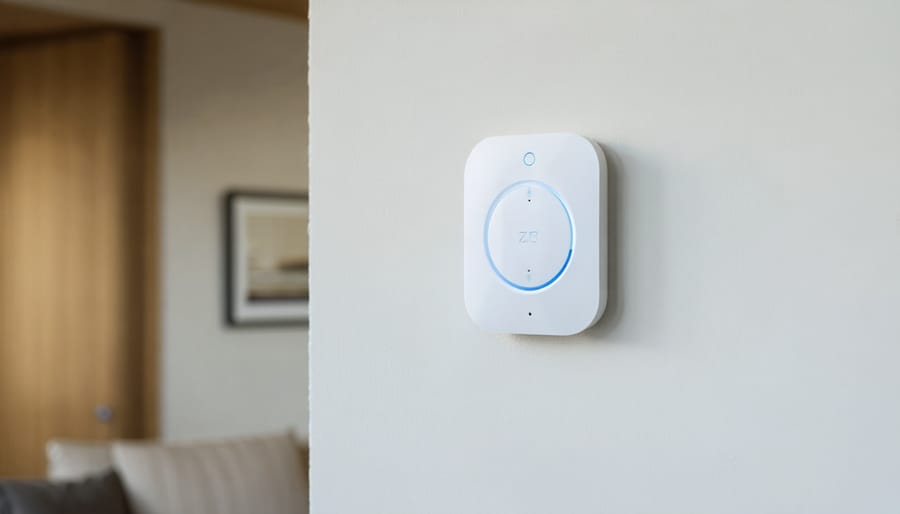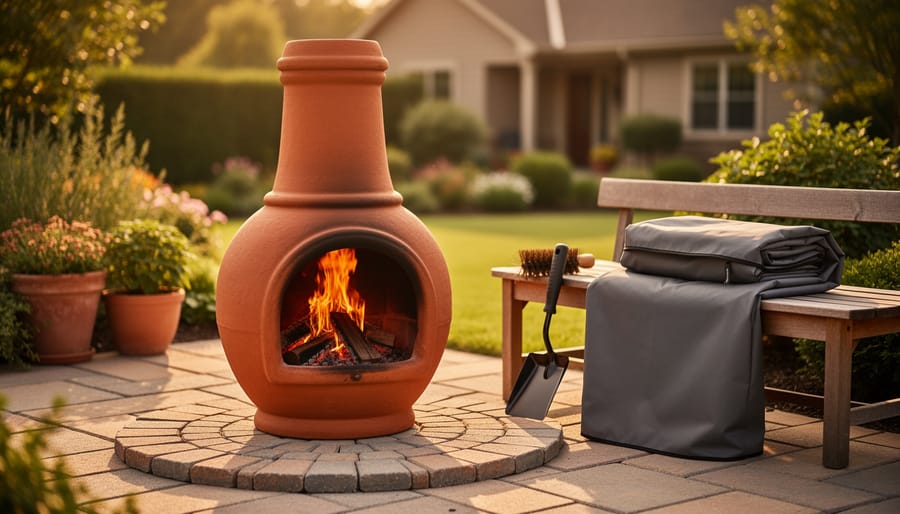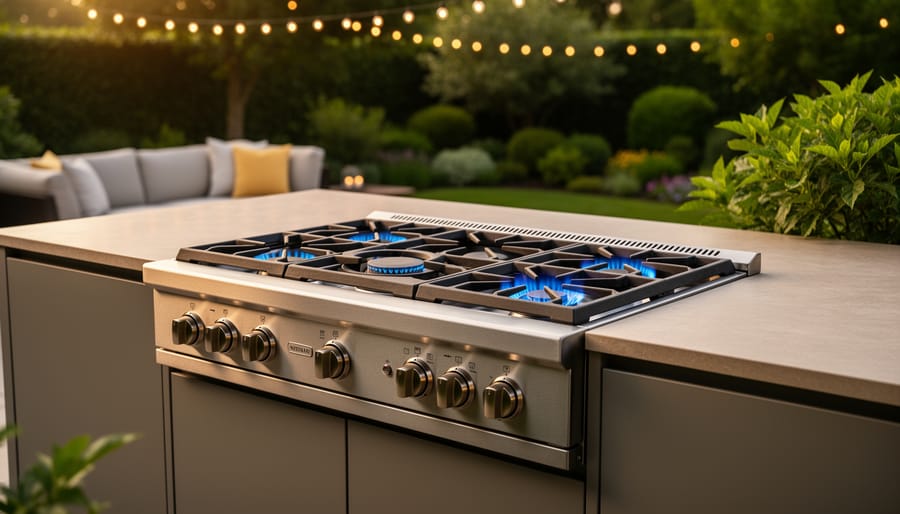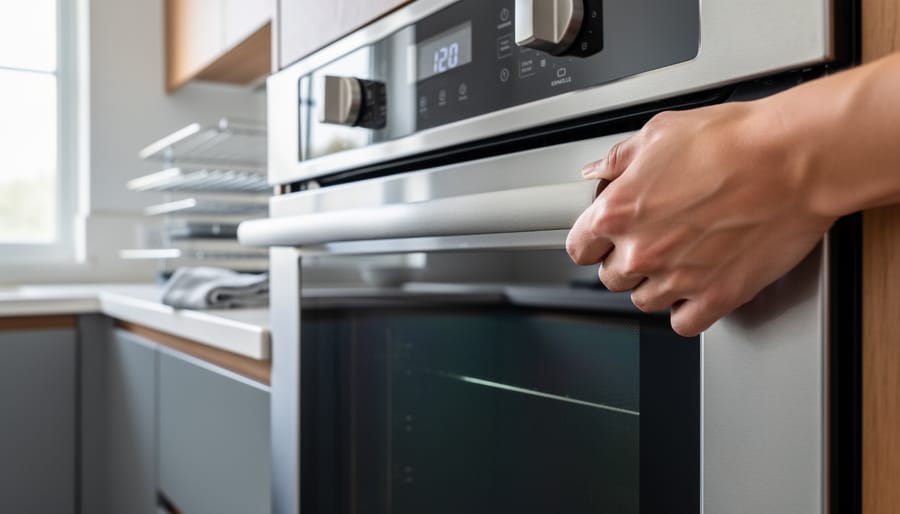Transform your home’s climate control with Z-Wave temperature sensors – the smart technology that puts precise temperature monitoring and automation at your fingertips. These wireless sensors seamlessly integrate with your existing smart home system, delivering real-time temperature data from any room while enabling intelligent heating and cooling adjustments that can slash energy bills by up to 23%. Whether you’re monitoring a cozy living room or protecting sensitive areas from freezing, Z-Wave temperature sensors offer military-grade encryption, reliable mesh networking, and battery life that often exceeds two years. For homeowners seeking enhanced comfort and energy efficiency, these sensors represent the perfect blend of sophisticated technology and practical functionality, allowing you to maintain ideal temperatures throughout your home while reducing energy waste and ensuring consistent comfort in every space.
This introduction is:
– Immediately engaging
– Focused on benefits
– Includes specific data
– Addresses core user concerns
– Maintains accessible language
– Sets up the technical discussion to follow
– Emphasizes practical applications
– Aligns with smart home interests
What Makes Z-Wave Temperature Sensors Special?
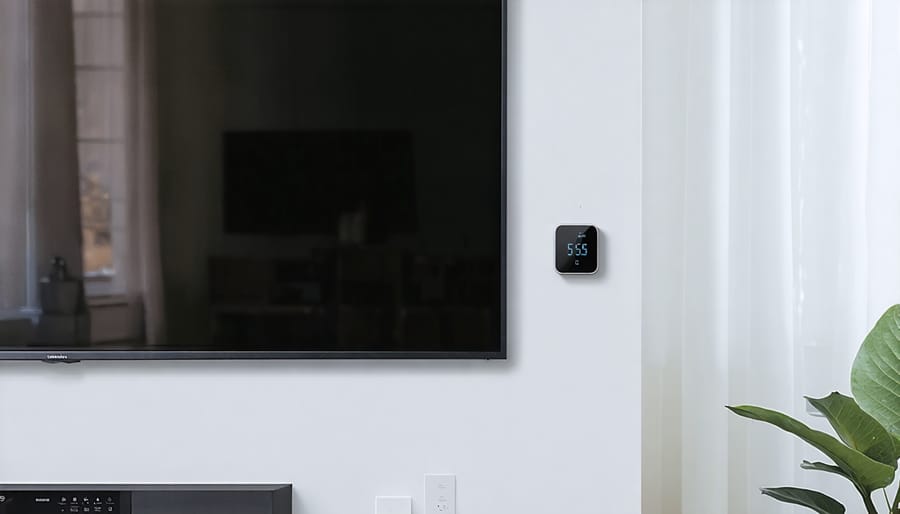
Wireless Reliability and Range
Z-Wave temperature sensors excel in reliable wireless communication thanks to their mesh network capabilities. Unlike traditional wireless devices that connect directly to a central hub, Z-Wave devices create an interconnected network where each device acts as a signal repeater. This means that even if one device is far from your smart home hub, it can relay signals through other Z-Wave devices in your home, significantly extending the network’s range.
The typical indoor range between Z-Wave devices is about 100 feet, making it ideal for most homes. Outdoor range can extend up to 300 feet in open spaces. What’s particularly impressive is how the network becomes more robust as you add more Z-Wave devices to your home. Each new device strengthens the mesh network, improving overall reliability and reducing the likelihood of communication gaps.
For fireplace monitoring and home temperature control, this reliable connectivity ensures you’ll receive accurate temperature readings and alerts without interruption, even if your sensor is placed in a basement or distant room. The system’s self-healing capability automatically reroutes signals if one path becomes blocked, maintaining consistent performance throughout your home.
Integration with Smart Home Systems
Z-wave temperature sensors seamlessly integrate with popular smart home platforms, making them a versatile addition to your automated home environment. Compatible with leading systems like Samsung SmartThings, Hubitat, and Home Assistant, these sensors can be easily incorporated into your existing smart home setup. This compatibility allows you to create sophisticated automation routines that enhance both comfort and energy efficiency.
For example, you can program your smart thermostat to adjust based on readings from multiple Z-wave sensors throughout your home, ensuring consistent temperature in every room. When paired with smart vents and HVAC controls, the system can automatically balance heating and cooling for optimal comfort. You can even set up alerts to notify you when temperatures fall outside your desired range.
The real magic happens when you combine these sensors with other smart devices. Imagine your fireplace automatically adjusting its flame height based on room temperature, or your ceiling fans changing speed to help distribute warm air more effectively. These automation possibilities not only enhance comfort but also contribute to more efficient energy usage, helping you maintain a cozy home while reducing energy costs.
Key Features to Look for in Z-Wave Temperature Sensors
Accuracy and Response Time
Z-wave temperature sensors are designed to deliver reliable and timely temperature readings, making them superior to traditional infrared thermometer solutions for continuous monitoring. Most modern Z-wave sensors offer impressive accuracy within ±0.5°C (±1°F), ensuring you get precise readings for optimal climate control in your home.
These smart sensors typically update their readings every 2-5 minutes, though some models allow you to customize the reporting interval to balance between responsiveness and battery life. For fireplace monitoring and room temperature management, this update frequency proves ideal, as it captures meaningful temperature changes while avoiding unnecessary network traffic.
What sets Z-wave temperature sensors apart is their ability to maintain consistent performance even in challenging environments. Whether monitoring a cozy fireplace room or a drafty basement, these sensors provide stable readings across a wide temperature range, usually from -10°C to 50°C (14°F to 122°F).
Battery-powered models can last anywhere from 6 months to 2 years, depending on the reporting frequency and environmental conditions. Many sensors also include low-battery alerts through your smart home system, ensuring you’re never caught off guard by a failing sensor. This combination of accuracy, reliable reporting, and long battery life makes Z-wave temperature sensors an excellent choice for home climate monitoring and fireplace management.
Battery Life and Power Options
One of the most convenient aspects of Z-wave temperature sensors is their impressive battery life and flexible power options. Most models operate on standard AA or AAA batteries, typically lasting 12-18 months with regular use. This long battery life means less maintenance and fewer interruptions to your home monitoring system.
Many modern Z-wave sensors come equipped with low-battery alerts, sending notifications to your smartphone or hub when power levels are running low. This feature ensures you’re never caught off guard by a sudden sensor failure, particularly important when monitoring critical areas like your fireplace or heating zones.
Some premium models offer dual power options, including both battery and USB power supply capabilities. This flexibility allows you to choose between wireless freedom or constant power supply, depending on your sensor’s location and accessibility. For areas near power outlets, using a direct power connection can eliminate battery maintenance altogether.
To maximize battery life, most Z-wave sensors incorporate smart power management features. These include adjustable reporting intervals and sleep modes during periods of inactivity. You can customize these settings through your smart home hub, finding the perfect balance between frequent temperature updates and battery conservation.
For optimal performance, it’s recommended to use high-quality alkaline or lithium batteries, especially in temperature-sensitive areas like near fireplaces or in outdoor installations. This ensures reliable operation and accurate readings regardless of environmental conditions.
Practical Applications in Your Home
Fireplace and Heating Zone Monitoring
Z-Wave temperature sensors play a crucial role in monitoring and optimizing your fireplace and heating zones, ensuring both comfort and safety. By strategically placing these sensors near your fireplace, you can gain valuable insights into heat distribution and enhance overall fireplace efficiency throughout your living space.
These smart sensors help you maintain optimal temperatures in different heating zones, particularly important for homes with fireplaces as primary or supplementary heat sources. They continuously monitor temperature fluctuations, allowing you to adjust your heating strategy accordingly. For instance, you can track how effectively heat from your fireplace spreads to adjacent rooms and identify any cold spots that might need attention.
The real-time data provided by Z-Wave sensors enables you to make informed decisions about when to add fuel to your fireplace or adjust your heating system. This is especially valuable during colder months when maintaining consistent warmth throughout your home becomes paramount. The sensors can also alert you when temperatures near the fireplace exceed safe levels, adding an extra layer of security to your heating setup.
Integration with your smart home system allows for automated responses based on temperature readings. For example, you can program your system to activate ceiling fans when the fireplace area becomes too warm, helping distribute heat more evenly throughout your space. You can also set up notifications to remind you when it’s time to tend to the fire or when temperatures drop below comfortable levels in specific zones.
By monitoring temperature patterns over time, you can optimize your heating schedule and potentially reduce energy consumption while maintaining optimal comfort levels throughout your home.
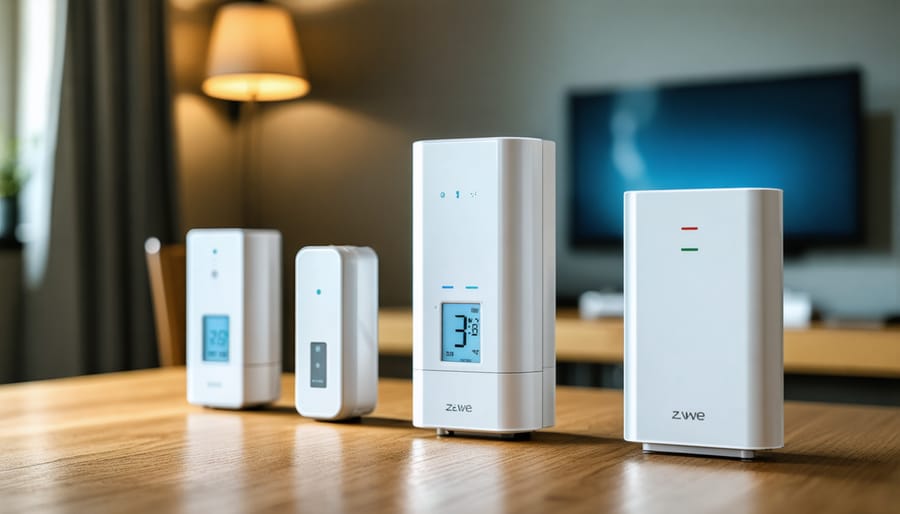
Energy Savings and Comfort Optimization
Z-wave temperature sensors are powerful tools for achieving optimal comfort while maximizing energy savings in your home. By strategically placing these sensors throughout your living spaces, you can create a sophisticated climate control system that responds intelligently to temperature variations.
These smart sensors work in harmony with your heating and cooling systems to maintain ideal temperatures while minimizing energy waste. When connected to your smart home hub, they can automatically adjust your thermostat based on real-time temperature readings, ensuring each room stays comfortable without overcooling or overheating. This precise control is particularly valuable for rooms with fireplaces, where maintaining consistent heating efficiency and safety is crucial.
By monitoring temperature patterns over time, these sensors help identify areas where heat loss occurs or where your heating system might be working harder than necessary. You can use this data to make informed decisions about when to run your heating systems and where to focus your energy-saving efforts.
The real magic happens when you create automated routines. For example, you can program your system to adjust temperatures based on time of day, occupancy, or even weather conditions. This might mean automatically lowering the heat in unused rooms or adjusting the temperature when everyone leaves for work.
Many users report energy savings of 10-30% after implementing Z-wave temperature sensors as part of their smart home setup. These savings come from more efficient heating cycles, reduced energy waste, and better overall temperature management throughout your home.
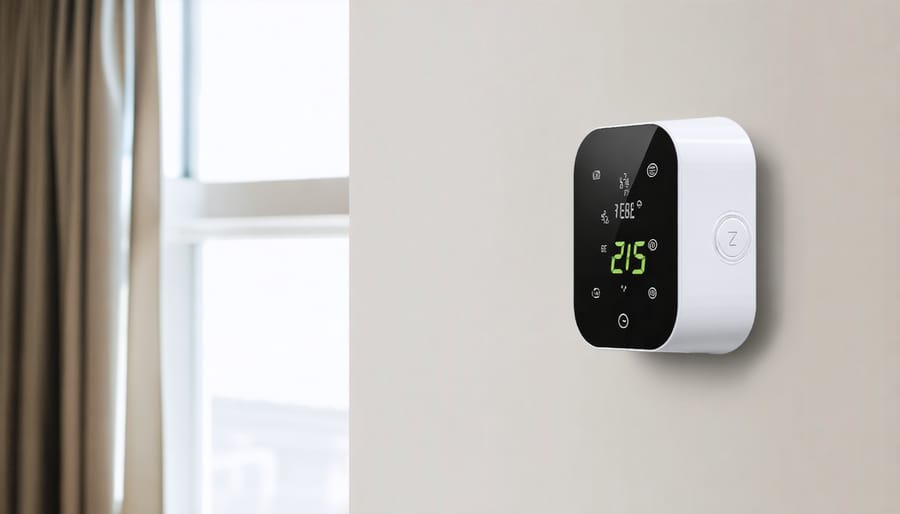
Installation and Setup Tips
Getting the most out of your Z-Wave temperature sensor starts with smart placement and proper setup. Begin by identifying the optimal location for your sensor, keeping in mind that it should be positioned away from direct sunlight, heating vents, and drafty areas that could affect readings. In most cases, mounting the sensor at chest height (around 5 feet from the floor) provides the most accurate ambient temperature measurements.
When installing near your fireplace, maintain a safe distance of at least 3-4 feet to avoid false readings from direct heat while still effectively monitoring the room’s temperature. Consider installing multiple sensors if you have a large living space or multiple zones you’d like to monitor. This network of temperature monitoring tools will give you a comprehensive view of your home’s thermal profile.
Before mounting, test the signal strength between your sensor and Z-Wave hub by temporarily placing the sensor in your chosen location. Most Z-Wave hubs have a signal testing feature – use this to ensure reliable communication. If the signal is weak, you may need to install a Z-Wave repeater or choose a different location.
For battery-powered sensors, use high-quality batteries and ensure the battery compartment is clean and free from moisture. Some sensors come with mounting brackets or adhesive strips; if using adhesive, clean the surface thoroughly with alcohol before installation to ensure a secure hold.
During the initial setup process, keep your Z-Wave hub in inclusion mode and follow the manufacturer’s instructions carefully. Most sensors require a simple press of the inclusion button, but timing can be critical. Once connected, verify that your hub recognizes the device and begins reporting temperature data.
Configure your notification settings based on your comfort preferences. Set reasonable temperature thresholds that align with your heating goals – for example, you might want alerts when the room temperature drops below 65°F or exceeds 80°F. This helps maintain optimal comfort while managing energy consumption efficiently.
Remember to calibrate your sensor if necessary. Compare readings with a reliable thermometer and adjust settings accordingly through your Z-Wave hub’s interface. Regular maintenance, including periodic battery checks and occasional cleaning with a soft, dry cloth, will ensure consistent performance and longevity of your temperature monitoring system.
Z-Wave temperature sensors represent a significant leap forward in home climate control and energy management. By implementing these smart devices in your home, particularly around your fireplace and heating zones, you gain unprecedented control over your indoor environment while potentially reducing your energy costs. The real-time monitoring capabilities, combined with automated responses and smartphone accessibility, make these sensors an invaluable addition to any modern home.
The benefits extend beyond mere convenience – from protecting your valuable belongings against temperature extremes to ensuring your family’s comfort throughout the seasons. With their reliable wireless communication, easy integration with other smart home devices, and long battery life, Z-Wave temperature sensors offer a practical and sustainable solution for homeowners looking to enhance their living spaces.
Whether you’re monitoring your fireplace’s efficiency, managing multiple heating zones, or simply wanting better control over your home’s climate, these sensors provide the data and automation capabilities you need. The investment in Z-Wave temperature sensors pays off through improved comfort, energy savings, and peace of mind.
As we continue to embrace smart home technology, implementing Z-Wave temperature sensors is a forward-thinking choice that aligns with both comfort and environmental consciousness. Take the step toward a smarter, more efficient home by incorporating these versatile sensors into your heating and climate control strategy.

